Exploring the Alsouq: Dubai's Traditional Market
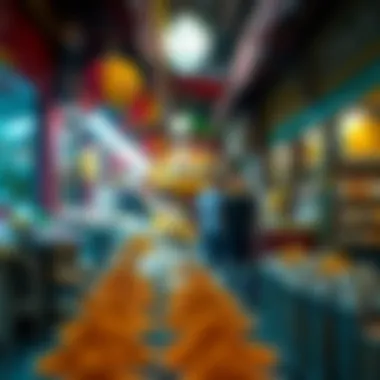
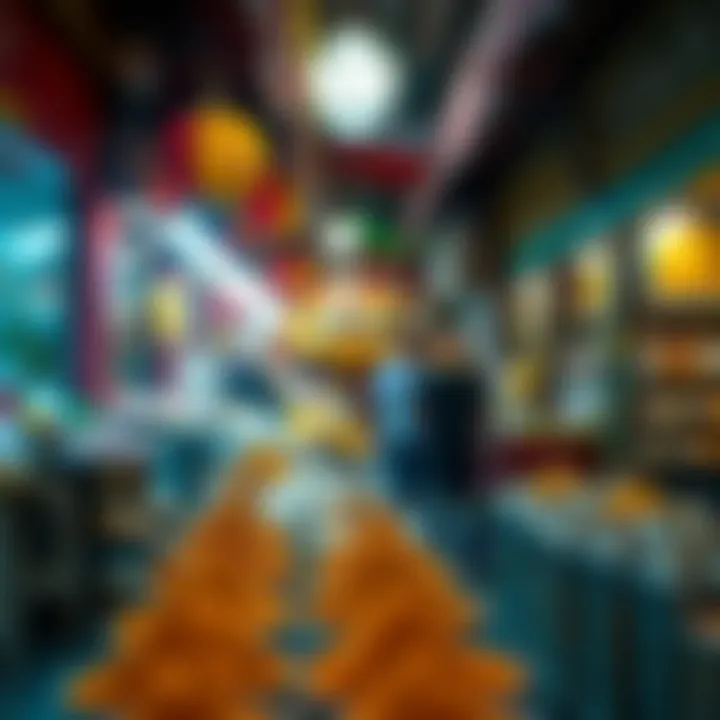
Intro
The Alsouq is more than just a market; it’s a tapestry woven into the very fabric of Dubai's cultural identity. For centuries, traditional markets have stood as a beacon of local commerce, fusing elements of trade, culture, and community life. This section sets the stage for a deep dive into the Alsouq’s historical significance, the modern shifts it has undergone, and the myriad experiences it offers.
Nestled within the bustling streets of this cosmopolitan metropolis, the Alsouq embodies a rich heritage, allowing visitors to indulge in a variety of offerings ranging from spices and textiles to jewelry and artisanal crafts. While the likelihood exists that one may find luxury malls in every corner of Dubai, the essence of the Alsouq creates a different sort of allure—it’s the pulse of a city steeped in tradition but ever-evolving in response to contemporary needs.
As we embark on this exploration, we’ll unravel not just the physical layout and structure of the Alsouq but also its economic weight in today’s market. We’ll answer the questions of why such a space remains relevant amid rapid urban development and how it preserves the local traditions that many would otherwise forget. Through understanding the complexities and vibrancy of this cherished market, readers will gain insights into both the heritage of Dubai and its projections into the future.
Preface to Alsouq
The Alsouq stands as a pillar in Dubai’s rich tapestry of heritage and commerce. It's more than just a market; it resonates with the pulse of the city, epitomizing a fusion of tradition and contemporary dynamics. As the article unfolds, we will explore the intricate layers that compose the Alsouq, each demanding a closer look at its importance to both residents and tourists.
The essence of the Alsouq lies in its ability to weave together the past and the present. From bustling stalls brimming with local handicrafts to the air thick with exotic spices, stepping into the Alsouq is like stepping into a living museum. Here, the spirit of Dubai’s historical trade routes emerges, showcasing the interplay of cultures that has defined the emirate for centuries. It’s not merely a point of sale; it’s a vibrant symbol of Dubai’s identity.
In practical terms, understanding the Alsouq helps investors, buyers, and agents appreciate the broader economic landscape of Dubai. Traditional markets like the Alsouq contribute significantly to local communities and their economies. They support small businesses and artisans, enriching the market experience for all who engage with it. In today’s fast-paced world, where online shopping often overshadows physical stores, places like the Alsouq remind us of the richness that face-to-face interactions can bring.
"A traditional market is not just about buying and selling. It is a social hub, a feast for the senses, and a testament to cultural resilience."
The exploration of this market begins with diping into the cultural significance that traditional markets hold, followed by an examination of its historical backdrop, setting the stage for a deeper appreciation of the Alsouq. Each facet plays a crucial role in why this market continues to thrive, and understanding these dynamics is essential for anyone invested in the future of Dubai’s economic and cultural landscape.
Architecture and Layout
The architecture and layout of the Alsouq serve as the backbone of its charm and functionality, bridging the past with modern tastes. When you stroll through its narrow lanes, you can’t help but appreciate how every element is thoughtfully placed. The design is not just about aesthetics; it’s about creating an experience. The traditional style isn't merely a nod to history; it’s a deliberate choice that enhances the shopping experience and customer engagement.
Traditional Design Elements
When you talk about traditional design elements, let’s take a closer look at factors like materials and colors. The use of weathered wood, local stone, and vibrant fabrics characterize the stalls and structures. The arched doorways and intricately carved wooden screens are not just eye candy; they provide shade and ventilation in the scorching heat. This sort of design reflects a pragmatic approach to climate, making the market a comfortable place to shop, while still being deeply entwined in cultural practices.
Some key features include:
- Mud brick and palm frond walls: These materials were historically used for insulation and ventilation.
- Mashrabiya screens: A nod to traditional Arab architecture, these elements enhance privacy and allow for airflow.
- Colorful tile work: Each vibrant hue tells a story or represents local culture.
"The architecture speaks a language of history that resonates within the heart of every visitor."
Spatial Organization of Stalls
Next comes the spatial organization of the stalls, which is not as random as it may seem. The layout is intentionally designed for flow and ease of movement. It encourages visitors to wander and explore every nook and cranny of the market. Central squares often serve as gathering spots, where performers might play while sellers beckon patrons to their stalls.
In more practical terms, the stalls are often grouped by product type, such as textiles in one section and spices in another, which creates a sensory adventure. This organization makes it easier for both locals and tourists to navigate.
Consider these aspects of stall organization:
- Concentration of similar goods: This keeps shoppers focused while promoting competition among sellers.
- Ease of navigation: Pathways are kept clear, ensuring foot traffic does not bottleneck, thus enhancing the shopping experience.
- Community spaces: Areas where locals can gather not only serve to sell products but foster community ties.
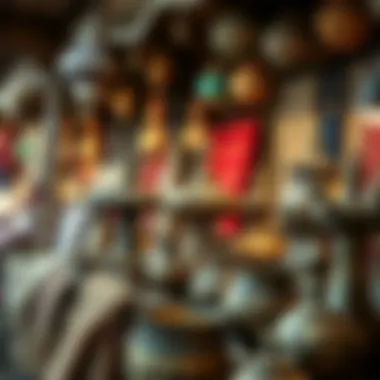
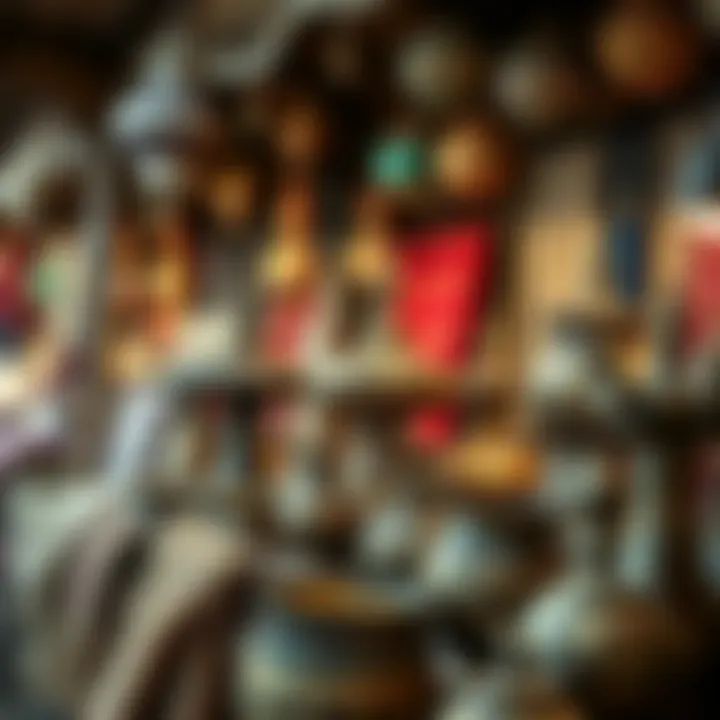
In summary, the architecture and layout of the Alsouq aren’t mere afterthoughts but essential elements that craft an intricate tapestry of Dubai’s cultural fabric. Through traditional design and effective spatial organization, the market continues to thrive while preserving its rich heritage.
Variety of Goods and Services
The Alsouq in Dubai stands as a testimony to the rich array of traditions and aromas that breathe life into the bustling marketplace. This section delves into the significant role the variety of goods and services plays within the Alsouq, exploring how it not only enhances the shopping experience but also contributes to the economic fabric of the region. Each category of products—textiles, spices, and jewelry—reveals a unique facet of cultural heritage and provides insight into local craftsmanship that has stood the test of time.
Textiles and Handicrafts
One of the most captivating sections of the Alsouq resonates with the colorful presence of textiles and handicrafts. The market showcases a kaleidoscope of colors, from rich fabrics adorning garments to intricate rugs that tell stories of history. Handwoven items, such as traditional abayas and kaftans, are often crafted with great care, reflecting the skills passed down through generations.
The importance of textiles in the market goes beyond aesthetics; they hold cultural significance and are often tied to local customs and ceremonies. This element brings together not just customers, but also artists and artisans who engage in fair trade, benefitting from the exposure to a wider audience. Shoppers can expect to spot unique designs and unexpected finds that cannot be replicated, making every visit a new adventure.
Spices and Gourmet Foods
The air in the Alsouq is thick with the enticing aromas wafting from spice stalls. Herein lies a culinary haven where spices play a starring role. Visitors encounter spices like za’atar, saffron, and sumac, often accompanied by vendors’ stories that highlight the heritage of each product. The diversity of spices not only serves to enhance local dishes but also ignites creativity among chefs looking for exotic flavors to incorporate into their offerings.
Exploring the spice section is akin to taking a journey through the Middle East. Each blend has its roots entwined in the region's history, often used in traditional medicine and cooking. Shoppers searching for gourmet foods can find dried fruits, nuts, and artisanal products that invite them to savor the local palate, all while offering a taste of Dubai’s culinary legacy.
Jewelry and Artisanal Products
Moving from the vibrant spices, one is drawn into the glimmering world of jewelry and artisanal products. The jewelry stands often captivate with their delicate gold filigree and colorful gemstones that narrate tales of luxury and cultural significance. Gold, in particular, symbolizes not just wealth but also traditional craftsmanship that Dubai is known for. This is evident during the various festivals and events where residents proudly display their culturally significant jewelry.
Beyond conventional jewelry, the Alsouq showcases artisanal products that range from handmade pottery to intricate woodwork. These items are often mixed with modern techniques, showcasing how tradition meets innovation. Shoppers looking for unique pieces can find handcrafted treasures that are often less available in contemporary shops, highlighting the artisans' dedication and skill.
In summary, the variety of goods and services at the Alsouq enriches the shopping experience while preserving traditional methods and enhancing economic growth. Understanding the cultural significance behind textiles, the aromatic allure of spices, and the captivating charm of jewelry fosters a deeper appreciation of this vibrant market.
"In Dubai's Alsouq, every stall tells a story and every purchase is an embrace of tradition."
For further insights into the products and culture of various markets, readers can explore resources such as Wikipedia or Britannica for an expansive view.
Economic Impact of Alsouq
The Alsouq represents more than just a shopping destination; it is a cornerstone of economic vitality in Dubai. This market, steeped in tradition, plays a pivotal role in promoting local businesses while attracting a steady flow of visitors. When we analyze the economic impact of the Alsouq, one can’t ignore how it intertwines with local culture and commerce, ultimately creating a unique tapestry that supports both the community and the economy at large.
Contribution to Local Economy
The seat of numerous small enterprises, the Alsouq fuels Dubai’s economy by providing essential livelihoods. Local vendors, artisans, and craftsmen showcase their goods, resulting in direct income for these individuals. Unlike large chain stores, the stalls often represent family businesses that have passed down through generations, fostering not only economic stability but also cultural heritage preservation.
Moreover, these markets generate substantial revenue for the city. Estimates suggest that millions of dirhams flow through the Alsouq each year. The presence of these traditional markets has a multiplier effect. For instance, a local spice vendor's sale not only benefits them but also enhances the business prospects for nearby cafes and restaurants seeking to source unique flavors.
Additionally, as an economic engine, Alsouq’s offerings attract diverse business ventures, prompting investments from both local and international entities. This influx barrels into various sectors such as retail, hospitality, and tourism. In fact, an upturn in businesses associated with Alsouq often leads to more job opportunities and stimulates economic development in surrounding areas.
Tourism and Community Engagement
Tourism is another vital aspect where the Alsouq excels. Travelers actively seek authentic experiences, and the market provides just that. Each visit enchants tourists with its rich array of textiles, spices, and handicrafts, offering them not just products but also stories that reflect Dubai's traditions. This cultural authenticity turns casual visitors into brand ambassadors, promoting the destination on a global scale.
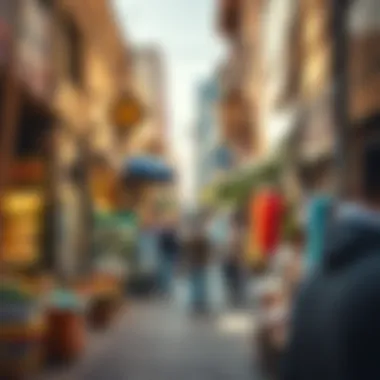
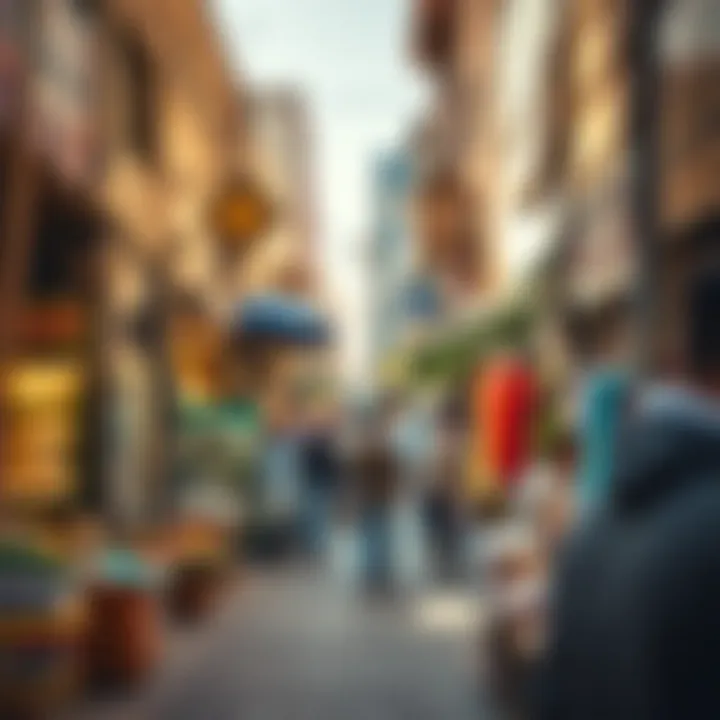
From art exhibits to cultural performances hosted within the market, there's continuous community engagement. Tourists often participate in workshops that teach traditional crafts, providing a deeper understanding of the local culture. This kind of engagement fosters a sense of pride among residents.
Moreover, as local businesses cater to international visitors, they adapt by improving product quality and customer service, which raises the overall standard of the marketplace. It’s a win-win situation, laying the groundwork for sustainable relationships between community and tourists.
Overall, the Alsouq serves as a microcosm of Dubai's thriving economic landscape. Its economic footprint reaches wide, affecting local vendors, tourism, and community dynamics, while demonstrating resilience in a rapidly changing environment.
Sustainability and Future Challenges
The Alsouq stands at an intricate crossroad where tradition meets the inevitable push of modernity. As the world increasingly shifts towards sustainable practices, the Alsouq faces the pressing challenge of balancing its rich cultural heritage with contemporary economic demands. Understanding sustainability in this context is not just about preserving old methods; it’s about ensuring that this cornerstone of Dubai's identity can thrive in an ever-evolving marketplace.
Preservation of Traditional Practices
Preserving traditional practices within Alsouq is about more than mere nostalgia; it’s a form of cultural resilience. The artisans and shopkeepers play an integral role in passing down skills that might otherwise fade into oblivion. For instance, the craftsmanship seen in handmade textiles or intricate jewelry not only carries aesthetic value but also embodies centuries of knowledge and tradition.
Sustainability in this preservation requires a commitment from both locals and visitors. Incorporating practices such as:
- Use of local materials: Reducing the carbon footprint by sourcing from nearby areas, making traditional methods more environmentally friendly.
- Workshops and education: By hosting classes, the market allows the younger generation to learn these skills, ensuring that the knowledge does not die out.
Furthermore, there’s a rising trend among conscious consumers who yearn for authenticity paired with sustainability. They’re more inclined to support products that tell a story. Thus, by keeping traditional techniques alive, Alsouq doesn’t merely preserve the past; it also solidifies its relevance in the present and future.
Adapting to Modern Consumer Needs
On the flip side, adapting to modern consumer needs poses its own set of challenges and opportunities. Today’s shoppers are not merely looking for the goods; they seek an experience that resonates with their values. This means that Alsouq must evolve while maintaining its traditional vibe.
Embracing technology could bridge the gap between old and new. For example:
- Online presence: Creating a platform for artisans to showcase their goods can attract a wider audience. Many small businesses have taken to social media to promote their offerings, which enhances visibility and sales. Websites like Instagram have become virtual marketplaces.
- Eco-friendly packaging: Offering sustainable packaging can also appeal to the modern consumer's sensibilities, signaling a commitment to environmental issues.
It’s no longer enough to rely solely on foot traffic. In catering to a generation that values convenience, Alsouq must consider various technological advancements to thrive. In this way, the market can remain a hub of cultural exchange while reflecting the changing needs of its diverse audience.
"To embrace the future, Alsouq must blend its rich past with the realities of modern demands, thus creating a sustainable model for generations to come."
Experiential Aspects of Alsouq
The Alsouq, as a traditional market, provides far more than mere shopping. It immerses visitors in an experience that speaks volumes of Dubai's heritage, crafts, and culinary art. The vibrant kaleidoscope of sights, sounds, and smells creates an atmosphere that captivates both tourists and locals alike. Understanding these experiential aspects is crucial for anyone looking to fully appreciate this iconic market.
Navigating the Market
Wandering through the narrow pathways of Alsouq is akin to navigating a labyrinth—each twist and turn may lead you to a hidden gem or a bustling stall. The layout, while seemingly haphazard, is designed to encourage exploration. First-time visitors might feel a tad overwhelmed by the sheer variety of goods on display. Yet, it is this very confusion that enriches the experience, inviting deeper interactions with vendors and the culture itself.
Many visitors find it useful to have a sort of personal roadmap, not just of where to find goods but to discover stories of the vendors who sell them. Taking the time to chat with these individuals can provide insights into their crafts that you won’t find just reading placards. You may just hear about the art behind traditional weaving techniques or the historical significance of a family recipe for a spice blend.
"Navigating the market is not just about the destination, it’s about the journey and the people you meet along the way."
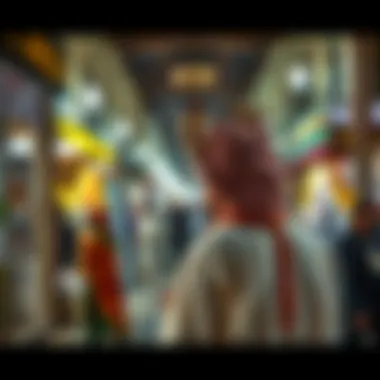
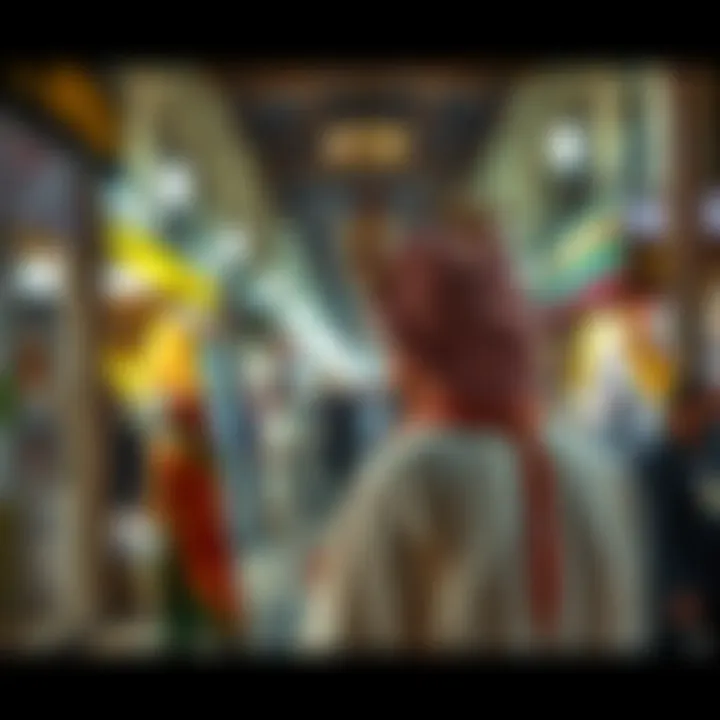
For a more seamless experience, consider visiting during early hours when the crowd is thinner. This way, you can converse with the stall owners without the hustle and bustle overshadowing the dialogue. Additionally, carrying cash might help, as many vendors prefer this method for transactions.
Culinary Experiences and Sampling
When it comes to Alsouq, the culinary experiences are simply out of this world. The market serves as a delightful melting pot of flavors that represent the diverse cultures of Dubai. From vibrant spices with heady aromas to sweet dates that burst with flavor, sampling the goods here is practically a rite of passage.
One can partake in a series of tastings that might include:
- Freshly Ground Spices: The intense aroma from stalls makes it hard to resist. Vendors often offer samples, allowing you to smell and taste spices like za'atar or saffron before purchasing.
- Traditional Baklava: Sweet layers of pastry, nuts, and honey might just have you returning for seconds. The skill of the baker may be felt in every bite, making it an unforgettable treat.
- Locally Brewed Coffee: It’s not just a drink but a cultural experience. Middle Eastern coffee, served strong and often flavored with cardamom, invites you to slowly savor while enjoying conversations.
Moreover, many stalls encourage visitors to engage with culinary traditions by offering cooking demonstrations. This interactive aspect not only connects individuals to the food but to the cultural practices that shape their preparation and consumption.
Engaging in culinary experiences at Alsouq can also serve as a gateway to learning, igniting an appreciation for the depth and richness of the regional cuisine. Overall, culinary sampling at the market isn't merely about food itself; it’s an enriching contact with the community, culture, and history embedded in each dish.
Comparative Analysis with Other Markets
Analyzing the Alsouq in the context of other traditional markets offers profound insights into its unique appeal and operational dynamics. Traditional markets, or souks, are not just places for buying and selling; they are cultural hubs that reflect local customs, community interaction, and economic vitality. Understanding the nuances between these markets can help investors, buyers, and agents appreciate the distinctive nature of Dubai's Alsouq, especially as they navigate the complexities of the global market.
Similarities with Souks in Other Regions
When we travel through various regions, we find that many traditional markets share common threads—vibrant atmospheres, an assortment of local goods, and an undeniable sense of community. For instance, the Grand Bazaar in Istanbul is famous for its sprawling stalls packed with carpets, spices, and jewelry, echoing the diversity found in the Alsouq. Both markets pulse with life and serve as social gathering spots, where traders and patrons engage in bartering and storytelling over fragrant cups of tea.
Moreover, the souk in Marrakech shares a kinship with the Alsouq as both cater to a wide array of tastes, from textiles to gourmet foods. These locales aptly demonstrate the universal appeal of traditional markets as spaces that allow both locals and tourists to immerse themselves in local culture.*
“Markets like the Alsouq are not merely for commerce; they are the heartbeat of community connections.”
However, the similarities can sometimes create the risk of viewing the Alsouq merely as an extension of these other markets. This overlooks the unique cultural and commercial significance the Alsouq holds within Dubai's burgeoning economic landscape.
Unique Characteristics of Dubai's Alsouq
Diving deeper reveals distinctive features that set the Alsouq apart from other traditional markets. One significant element is its seamless blend of tradition and modernity, which caters to the demands of discerning buyers and visitors. Unlike some souks that might cling to age-old practices, the Alsouq embraces innovation while retaining its cultural essence. For instance, the incorporation of modern payment systems alongside traditional negotiation styles showcases this market's adaptability.
In addition, Dubai's Alsouq often caters to a more diverse international clientele than its counterparts in other regions. This cosmopolitan touch allows for the availability of unique products that resonate with various cultures, thus broadening the appeal of the market to tourists.
Moreover, the aesthetic flair of the Alsouq, with its intricate architectural designs and carefully organized layout, stands as a testament to Dubai’s vision of marrying heritage with contemporary luxury. Shoppers are not just here to buy; they are invited to engage with art and craftsmanship that reflect the rich history of the UAE.
The End
The Alsouq stands as a pillar of Dubai's cultural and economic landscape. Its importance extends far beyond being just a marketplace; it is a lively hub that connects people, sustains traditions, and adapts to the modern world. This article highlighted how Alsouq is a microcosm of the diverse interactions within the city—where old meets new, and tradition intertwines seamlessly with contemporary commerce.
Recap of Alsouq’s Importance
In essence, Alsouq is not just about buying and selling; it embodies the spirit of Dubai. It cultivates a sense of community, attracting both locals and tourists alike who come to immerse in its rich heritage. From handcrafted textiles to aromatic spices, each stand offers a piece of the city’s history tied together by a common thread of culture. As explored, the market's layout and architectural aspects resonate with the traditions of Arabic design, enhancing the cultural experience. Its impact on the local economy is notable, contributing significantly to both small businesses and larger commercial ventures. The market plays a vital role in preserving customs that might otherwise fade away in the face of modernization.
Call to Recognize and Support Traditional Markets
Supporting traditional markets like Alsouq is crucial for several reasons. For one, these markets nurture local artisans and craftsmen, helping them keep their skills alive amid new commercialization pressures. Recognizing their value encourages the continued practice of traditional methods, directly impacting the livelihoods of individuals and communities. In addition, traditional markets support local economies by attracting tourism and engaging residents in community events.
Investors and stakeholders have a unique opportunity to help the Alsouq thrive, ensuring that it remains a vibrant part of Dubai’s identity. By promoting initiatives that support these marketplaces—like festivals, educational workshops, and cultural events—there can be a rekindling of interest and respect for our shared heritage.
"If we do not appreciate our traditional markets, we risk losing not just commerce, but connections rooted in years of shared history."







